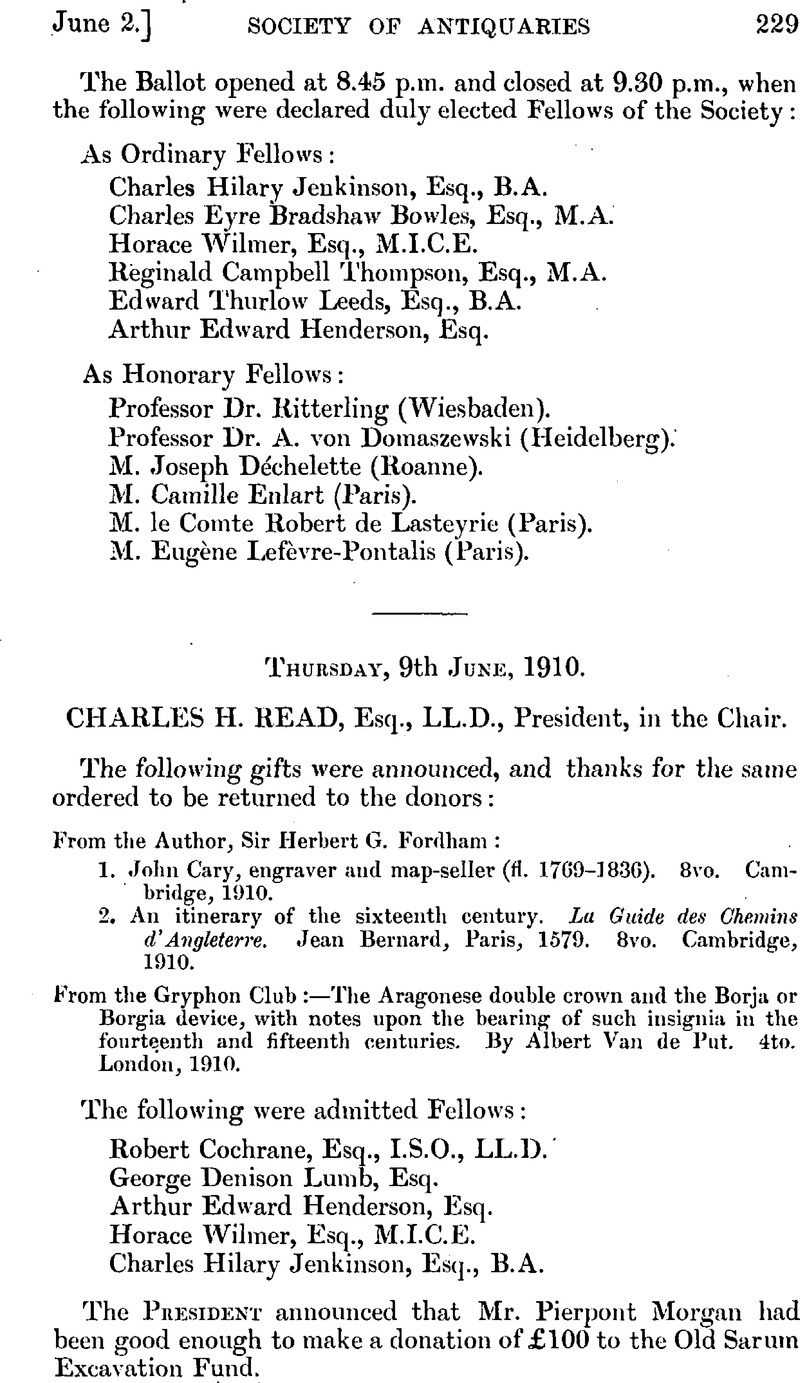No CrossRef data available.
Article contents
Thursday, 9th June, 1910
Published online by Cambridge University Press: 10 May 2010
Abstract

- Type
- Proceedings
- Information
- Copyright
- Copyright © The Society of Antiquaries of London 1911
References
page 230 note 1 Archaeologia Cambrensis, 6th ser. iii. 231.
page 230 note 2 Archaeologia, lxi. 113, and figs. 50, 60, 66, 77.
page 231 note 1 London and Middlesex Arch. Soc. Proc., 1862, 76 (with figs.) ; Times; 21 March, 1862; Illusrated London News, 5 April, 1802 ; Roach Smith, Collectanea Antiqua, vii. 194; Journ. Brit. Arch. Assoc., xviii. 382.
page 231 note 2 See also Proceedings, 1st ser. i. 57.
page 232 note 1 Journal of the British Archaeological Association, xx. 90.
page 232 note 2 Archaeologia, xxxi. 310; fig. on p. 308 ; Coll. Antiq., iii. 55.
page 232 note 3 London and Middlesex Arch. Soc. Trans., iii. 206, plates vi vii.
page 232 note 4 ‘Some 60 yards south of the Roman highway,’ presumably that distance from the modern Roman Road ; but p. 208 gives this site as 200 yards north of another find accurately located in Morville Street. Hence this coffin was probably found in Parnell Road (site 3), which is more than ¼ mile from Saxon or Coborn Road. On the other hand, some of the railway employés remember a stone coffin being found in Saxon Road (site 6).
page 232 note 5 Proceedings, 2nd S. xxi. 273 and form 2 on plate opposite p. 279 ; of. p. 274. Another brown-ware cup from York (York Museum) is imperfect, but has the surface intact.
page 234 note 1 Transactions, i. 192.
page 234 note 2 Contemporary maps show these works covering a large area now bounded by Tredegar and Mostyn Roads, and the railway lines on the east and south, but the exact site of the discovery cannot be determined. The area includes the finds in Lacey and Morville Streets.
page 234 note 3 Said to be like fig. 1 of plate vi, ibid. iii. 207.
page 235 note 1 This part of London was built over 1862–1887 : see a paper by our Fellow, Mr Gomme, , in Geographical Journal, xxxi (1908), 489CrossRefGoogle Scholar.
page 235 note 2 The lid was broken but complete when I examined it in April, 1907.
page 235 note 3 There is a temptation to regard the east-and-west burials as Christian, especially when there is no grave furniture, but the orientation of stone coffins varied considerably (e. g. Proceedings, 2nd S. xxi. 35).
page 236 note 1 This firm kindly informs me that the wharf has since been occupied by the Standard Ammonia Co.
page 236 note 2 Lysons, Environs of London, iii. 489).
page 237 note 1 Victoria Hist. London, i. 34, 96. Similar finds in Gresham Street (Lad Lane and Cateaton Street), in Archaeological Review, i. 276.
page 237 note 2 Silchester (Archaeologia, lix. 344); Wroxeter (T. Wright, Uriconium, 207); Chester, (Journ. Archit. Archaeol. and Hist. Soc. Chester, ii (1864), 314Google Scholar; iii (1885), 32; viii (1902), 87 ; Borough Hill, Northants (Archaeologia, xxxv. 384).
page 237 note 3 e. g. near Pola, Istria : Jahrbuch für Altertumskunde, ii. 132.
page 237 note 4 Victoria History of London, i. 31. The straight line from Romford to Holborn would coincide with Queen Street, south of Seven Kings station.
page 238 note 1 Archaeologia, lx. 180. Stukeley looked upon the morass as a defence for the city on the north (Itin. Curiosum, ii. 12); and it is conceivable that the Walbrook was allowed to flood Moorfields for this purpose.
page 238 note 2 London and Middlesex Arch. Soc. Trans. iii. 564 (with section).
page 241 note 1 This opinion is shared by Mr. W. A. Dutt, another local investigator (Knowledge, Feb. 1910).
page 241 note 2 M. Commont's inspiring work at St. Acheul is described in Bulletins de la Société linnéenne du Nord de France, and his papers are well summarized in L'Anthropologie, 1908, 534.
page 242 note 1 Palaeolithic flakes reworked in neolithic times are figured by Mr. Worthington Smith in Man, the Primeval Savage, 304–5.
page 243 note 1 Exceptperhaps one site in Kent which has produced hundreds of flints of peculiar type that I hope to bring before this Society next session.
page 244 note 1 Glaciations et Humanité, 64 (Bull, de la Soc. belge de Géologie, xxiv. 1910).
page 244 note 2 L'Anthropologie, 1909.
page 245 note 1 Trans. Royal Society of Edinburgh, xli. 699; xlv. 335; xlvi. 59, summarized in Science Progress, Oct. 1907; 307.
page 246 note 1 This does not occur in the lower forest bed (no. 8).
page 246 note 2 The temperate bed was therefore not proved to be interglacial (between upper and lower boulder clays) as contended by Mr. Bell (Quarterly Journal of Science, xiii. 293) and Sir Henry Howorth (Ice or Water, ii. 61). See Report of British Assoc., Liverpool 1896, p. 400.
page 247 note 1 The Hoxne palaeoliths seem to be of early St. Acheul type, whereas the brickearth at St. Acheul itself produces flints of the latest cave period. The Hoxne brickearth may be a much older deposit, or the implements may really have come from a lower stratum.
page 247 note 2 Man, the Primeval Savage, sections on pp. 76, 211.
page 247 note 3 Mr. Lamplugh does not recognize more than one Ice Age, but admits certain epochs within it and oscillations of the ice-limit (Presidential address, British Assoc. at York, 1906, p. 557).
page 248 note 1 Bulletin de la Société Belge de Géologie, vol. xxiii (1909), p. 234Google Scholar (translated).




